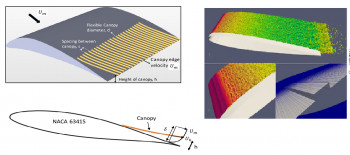News
Surface treatments for next generation quiet aerofoils
5 March 2021

The team of engineers from Queen Mary has won significant funding from the Engineering and Physical Sciences Research Council (EPSRC) devoted to high-resolution modelling and simulation of aerofoil noise. In the new £405,916 research project, Prof. Karabasov and his team will work in collaboration with the Institute of Sound and Vibration Research, Southampton and the University of Manchester.
The project idea stems from the invention, which has recently been made by the team at Virginia Tech led by Professors William Devenport and Stewart Glegg, collaborators in this project. They demonstrated that introducing ‘canopies’ into the turbulent boundary layer, which may be constructed from fabric, wires, or flexible rods, produced significant reductions in the surface pressure variation near the trailing edge, and hence similar reductions in the far field noise. These devices were chosen to reproduce the downy canopy that covers the surface of exposed flight feathers of many owl species.
Aerofoil self-noise is often the dominant noise source emitted from lifting surfaces, such as wings and turbine blades, and is a major issue in a number of strategically important sectors in the UK, including environment protection, energy and transport. Related work is in its early stages and the precise control mechanisms are still poorly understood. This 36-month project is concerned with establishing the fundamental physical control mechanisms of surface modifications with the objective of developing effective adjustments to aerofoil geometries at realistic Reynolds numbers and angle of attack that reduce noise without significantly degrading aerodynamic performance.
The project is a combination of state-of-the-art detailed experimentation with the application of latest advances in high-resolution computational methods, design optimisation and high-performance computing. At the heart of this project is the use of a new turbulent off-wall boundary condition to allow accurate modelling of the interaction between the boundary layer and canopy surfaces and the high-resolution unsteady flow simulation methods accelerated on Graphics Processing Units.
| Contact: | Sergey Karabasov |
| People: | Sergey KARABASOV Vassili TOROPOV |
Updated by: Sergey Karabasov




